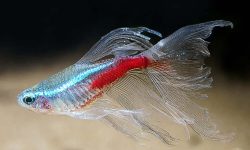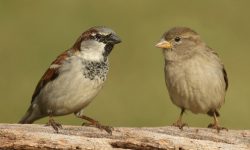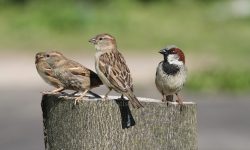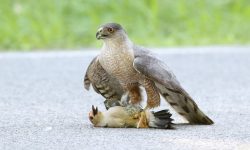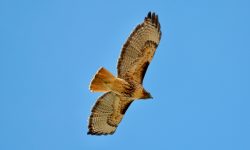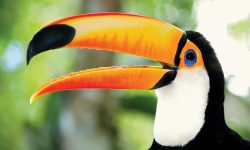The Common Blackbird (Turdus merula) is one of the most familiar and widespread birds across Europe, parts of Asia, and North Africa. Known for its melodious song, striking black plumage (in males), and orange-yellow beak, this species has adapted well to urban, suburban, and rural environments. Despite being called a “blackbird,” only the male is truly black—the female and juveniles are brown with streaks.
This article explores the species in detail, covering its physical characteristics, behavior, habitats, seasonal habits, and a deep dive into the foods it loves most.
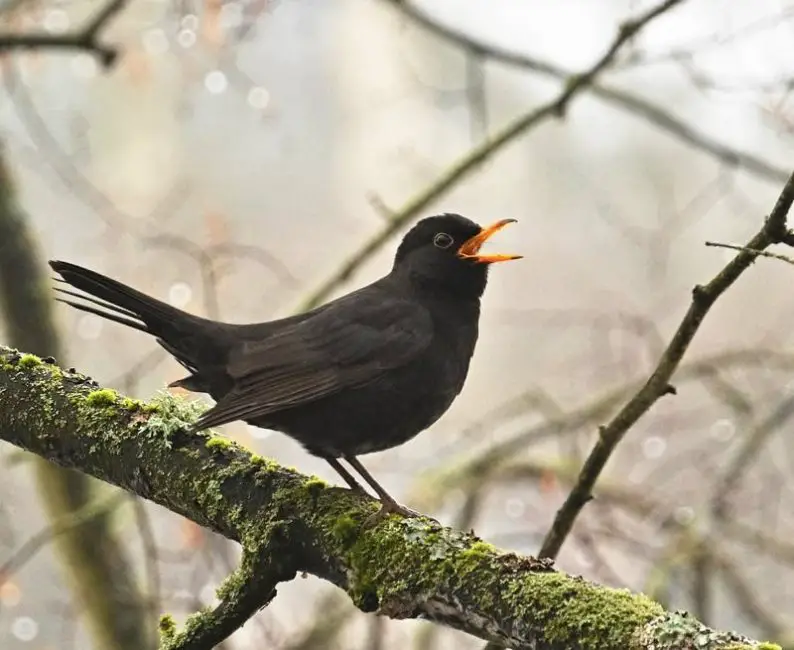
Physical Characteristics of the Common Blackbird
Sexual Dimorphism
The male Common Blackbird is glossy black with a bright orange-yellow beak and eye ring, giving it a bold appearance. In contrast, the female is dark brown with speckled markings on her chest and a duller brown beak.
Size and Weight
Adult blackbirds typically measure about 23.5 to 29 cm (9.25 to 11.4 inches) in length, with a wingspan of 34 to 38 cm (13.4 to 15 inches). They usually weigh between 80 to 125 grams.
Vocal Abilities
One of the most notable features of Turdus merula is its melodious and complex song, especially in the breeding season. Males sing from treetops and rooftops to mark territory and attract mates.
Habitat and Range
Geographic Distribution
The Common Blackbird is native to Europe, North Africa, and parts of Asia, but it has also been introduced to Australia and New Zealand where it is now well established. It thrives in a variety of habitats, from woodlands and forests to gardens, parks, and urban areas.
Urban Adaptability
In urban settings, blackbirds are highly adaptable. They nest in hedges, shrubs, and even building ledges. Their ability to forage in gardens and scavenge around human settlements has made them resilient and successful in modern landscapes.
Behavior and Breeding
Territorial Nature
Males are highly territorial during the breeding season, defending their space with both song and aggression. Fights between males can be fierce when territory boundaries are crossed.
Nesting and Reproduction
Blackbirds build cup-shaped nests using grasses, leaves, and mud. The female typically lays 3–5 bluish-green eggs and incubates them for about 13–14 days. Fledglings leave the nest roughly two weeks after hatching.
Seasonal Patterns
Most blackbirds are resident birds, meaning they stay in the same general area year-round. However, some populations in colder regions migrate short distances to escape harsh winters.
Diet of the Common Blackbird
Omnivorous Feeding Habits
The Common Blackbird is an omnivore with a diet that varies seasonally. It primarily feeds on invertebrates, fruits, and seeds, showing remarkable dietary flexibility. Below is an analysis of its most beloved foods.
Favorite Foods of the Common Blackbird
Earthworms: A Staple Source of Protein
Earthworms are perhaps the most iconic food associated with blackbirds. These birds forage early in the morning, using keen eyesight and head-cocking behavior to locate movement in the soil. Earthworms provide a high-protein diet essential during breeding and for feeding chicks.
Insects and Larvae
Beetles, caterpillars, spiders, and other insects are vital parts of their spring and summer diet. The abundance of soft-bodied insects during this period helps the blackbird support its young with nutrient-rich prey.
Berries and Wild Fruits
In autumn and winter, blackbirds switch to fruits and berries when invertebrates become scarce. They feast on elderberries, hawthorn berries, rowan berries, blackberries, dogwood berries, and holly berries. These provide energy-dense sugars and antioxidants needed for cold-weather survival.
Cultivated Fruits: Gardens and Orchards
In gardens and orchards, blackbirds are known to raid cherries, apples (particularly windfalls), pears, grapes, and plums. Though this may frustrate gardeners, it demonstrates the bird’s opportunistic nature.
Seeds and Grains
While not a staple, blackbirds occasionally consume seeds and grains, especially during winter when other food sources are scarce. They may visit bird feeders or forage under hedges where seeds fall.
Snails and Small Amphibians
Blackbirds have been observed eating small snails, especially in wet habitats. Their strong beaks help them crack open shells. In rare instances, they may also catch small amphibians like young frogs, especially near ponds.
Foraging Behavior
Ground Feeders
Unlike finches or tits, blackbirds are ground foragers. They hop and scratch leaf litter with their feet, searching for hidden insects and worms. Their foraging is often accompanied by head tilting, a technique thought to help them pinpoint prey movement.
Diurnal Patterns
Blackbirds are most active in early morning and late afternoon, when soil moisture is higher and prey such as earthworms are nearer the surface.
Seasonal Diet Variation
Spring and Summer
During the breeding season, protein-rich foods like worms and insects dominate the diet. Chicks are fed almost exclusively on soft-bodied invertebrates, as these are easier to digest and high in nutrients.
Autumn
Autumn is marked by a shift toward berries and fruits. This diet helps build fat reserves for winter and coincides with the peak availability of hedgerow berries.
Winter
In colder months, blackbirds rely heavily on fruits, fallen apples, and human-provided foods like raisins or soaked oats. In urban environments, they may visit feeders for mealworms or suet.
Ecological Role
Seed Dispersal
By consuming berries and excreting seeds elsewhere, blackbirds play a vital role in seed dispersal, aiding in plant reproduction across ecosystems.
Pest Control
Their appetite for insects and larvae makes them effective natural pest controllers, particularly beneficial to gardeners and farmers.
Interactions with Humans
Garden Visitor
Blackbirds are a common sight in gardens, where they are often tame and approachable. They may follow gardeners turning soil to snatch exposed worms or nest in thick shrubbery.
Conflict and Conservation
Although not currently endangered, blackbirds can come into conflict with fruit growers. Netting and other non-lethal deterrents are commonly used to prevent crop damage. Conservation efforts focus on preserving hedgerows and native plants, ensuring year-round food sources.
Blackbirds and Bird Feeders
What to Offer
Blackbirds are not adept at hanging feeders but readily take food from the ground or tray feeders. Ideal foods include mealworms, soft fruits (e.g., apple slices, raisins), suet pellets, and soaked bread or oats. Avoid salted or processed foods, which can be harmful.
Vocal Behavior and Territory
Song Purpose
The Common Blackbird’s song serves multiple roles: attracting mates, defending territory, and establishing presence in noisy urban environments. Songs are rich, fluty, and often delivered from high perches just before dawn or at dusk.
Alarm Calls
In addition to melodious song, blackbirds emit sharp, repetitive alarm calls when predators such as cats or hawks are nearby.
Predators and Threats
Natural Predators
Common Blackbirds are vulnerable to domestic cats, birds of prey (sparrowhawks, owls), magpies (egg and chick predation), and foxes.
Human-Related Threats
Although well-adapted to cities, blackbirds face threats from window collisions, loss of hedgerows, and insecticide use (which reduces invertebrate prey).
Conservation Status
According to the IUCN Red List, the Common Blackbird is classified as Least Concern, owing to its wide distribution and stable population. However, ongoing urbanization and climate change warrant continuous monitoring.
Efforts to protect this species include encouraging wildlife-friendly gardens, preserving native berry-producing plants, and reducing pesticide use.
Conclusion
The Common Blackbird (Turdus merula) is more than just a backyard bird. It is an adaptable, intelligent, and ecologically valuable species that plays a key role in pest control, seed dispersal, and the soundscape of both natural and urban environments. Its diet reflects its seasonal needs—rich in earthworms and insects in spring, and fruit-laden in autumn and winter. By understanding and supporting the feeding habits of the Common Blackbird, we not only ensure its survival but also contribute to a healthier, more biodiverse ecosystem.

